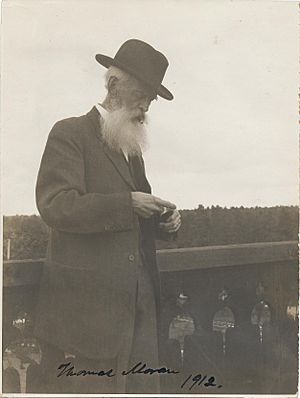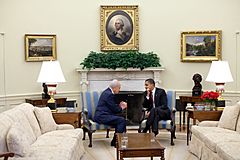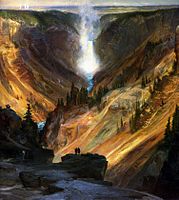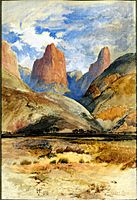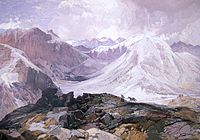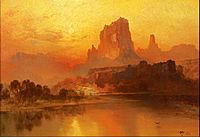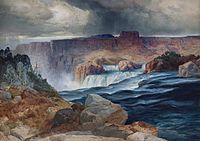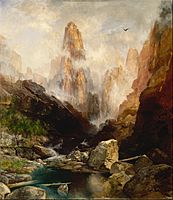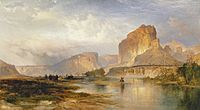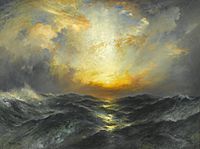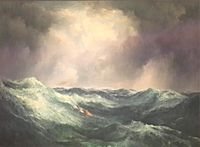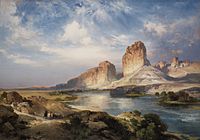Thomas Moran facts for kids
Quick facts for kids
Thomas Moran
|
|
|---|---|
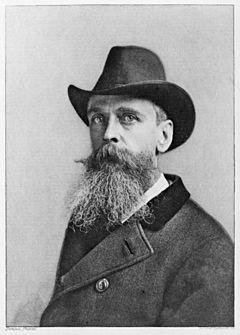
Thomas Moran by Napoleon Sarony
|
|
| Born | February 12, 1837 |
| Died | August 25, 1926 (aged 89) Santa Barbara, California, United States
|
| Nationality | American |
| Known for | Landscape painting |
| Movement | Hudson River School, Rocky Mountain School |
| Spouse(s) | Mary Nimmo Moran |
Thomas Moran (born February 12, 1837 – died August 25, 1926) was an American painter and printmaker. He was part of the Hudson River School in New York. His art often showed the beautiful Rocky Mountains.
Moran lived in New York with his wife, Mary Nimmo Moran, and their daughter, Ruth. He worked as an artist there. His older brother, Edward Moran, was also a famous marine artist, and they shared a studio. Thomas Moran was a skilled illustrator and used colors wonderfully. He became an illustrator for Scribner's Monthly magazine. By the late 1860s, he was the main illustrator. This job helped him become one of the best painters of American landscapes, especially the American West.
Thomas Moran, along with Albert Bierstadt, Thomas Hill, and William Keith, are sometimes called the Rocky Mountain School painters. This is because they all painted many Western landscapes.
Contents
About Thomas Moran's Life
Thomas Moran started his art journey as a teenager. He was an apprentice at a wood-engraving company in Philadelphia called Scattergood & Telfer. Moran found engraving "boring." So, he spent his free time painting with watercolors. By the mid-1850s, he was drawing the pictures for the company instead of carving them.
During this time, he saw illustrated books with art by the British artist J. M. W. Turner. Turner greatly influenced Moran's work for his whole life. Moran also began studying with a local painter named James Hamilton.
Learning and Traveling for Art
In 1862, Moran traveled to England to see Turner's paintings. From then on, he copied Turner's way of using color and choosing landscapes. He was also inspired by Turner's work with watercolor paints. Turner was very famous for his watercolors.
In the 1870s and 1880s, Moran's designs for wood-engraved pictures appeared in popular magazines. He was good at many printing methods, like wood-engraving, etching, and lithography. He learned these from his brothers. But he became most famous for his oil and watercolor paintings.
His career peaked when chromolithography became popular. This was a way to make color prints of his art. This meant his paintings could be shared with many people. He also helped bring back etching in the United States and Great Britain.
Moran's Family of Artists
Moran married Mary Nimmo Moran (1842–1899), who was from Scotland. She was also an etcher and a landscape painter. They had two daughters and one son.
His brothers Edward (1829–1901), John (1831-1902), and Peter (1841–1914) were also artists. His nephews Edward Percy Moran (1862–1935) and Jean Leon Gerome Ferris (1863–1930) were artists too. His brother John was a pioneer in artistic photography. John and Thomas often worked together. John would photograph the same scene that Thomas was painting. Thomas Moran passed away in Santa Barbara, California on August 25, 1926.
Painting the American West
Thomas Moran's paintings of the Western landscape were very important. They helped create Yellowstone National Park. In 1871, Dr. Ferdinand Hayden led the United States Geological Survey. He invited Moran to join his team on an expedition to the unknown Yellowstone region.
A rich American financier named Jay Cooke asked Hayden to invite Moran. Cooke called Moran "an artist of Philadelphia of rare genius." Cooke, who was in charge of the Northern Pacific Railroad, and Scribner's Monthly magazine paid for Moran to join the trip.
Yellowstone: A National Park is Born
Moran joined the Hayden Geological Survey of 1871 to explore Yellowstone. For 40 days, Moran drew more than 30 different places. He also kept a diary of the trip. His sketches, along with photos taken by another team member, William Henry Jackson, amazed the nation.
Their art helped convince Congress to make Yellowstone the first national park in 1872. Moran's paintings and Jackson's photos showed how grand and beautiful Yellowstone was. This helped persuade President Grant and the US Congress to protect Yellowstone.
Yellowstone greatly impacted Moran too. He became nationally famous and earned a lot of money because of his connection to Yellowstone. He even changed his signature to T-Y-M, which stood for Thomas "Yellowstone" Moran.
Just one year after seeing Yellowstone, Moran painted a huge picture of a Western wonder. It was called The Grand Canyon of the Yellowstone. The government bought it in 1872 for $10,000. For the next 20 years, he published his art and created hundreds of large paintings. Two of his famous works, The Grand Canyon of the Yellowstone (1872) and Chasm of the Colorado (1873–74), are displayed at the Department of the Interior Museum.

Over the next 40 years, Moran traveled a lot. He went back to Yellowstone with Jackson in 1892. They were invited by Elwood Mead, Wyoming's state engineer. This was to prepare for a "Wyoming Exhibition" at the World's Columbian Exposition.
By then, thousands of tourists could visit the park by train. Moran and Jackson used the tourist facilities, like a hotel at Mammoth Hot Springs. Moran wrote that he saw so much to sketch. He planned to return to the Grand Canyon area to work for a week. He said it was "as glorious in color as ever."
Moran sketched many more images of the Canyon on this trip than he had in 1871. This included views from "Moran Point," a spot named after him on the 1871 trip. The Grand Canyon of the Yellowstone (1893–1901) is now at the Smithsonian American Art Museum. Moran was chosen to be a member of the National Academy of Design in 1884. He created many artworks in his later years.
His Art in the White House
One of Thomas Moran's paintings is part of the White House collection. In a photo of President Barack Obama and Israeli President Shimon Peres in the Oval Office, you can see it on the wall. The painting is called The Three Tetons (1895). It hangs to the right of a portrait of George Washington.
Thomas Moran's Lasting Impact
The Thomas Moran House in East Hampton, New York is a very important historical site. Mount Moran in the Grand Teton National Park is named after him.
His art is kept in many museums. These include the Gilcrease Museum in Tulsa, Oklahoma, the Cooper-Hewitt, National Design Museum, the Amon Carter Museum of American Art, the R. W. Norton Art Gallery, and the Berkshire Museum in Pittsfield, Massachusetts.
Famous Paintings
- Nearing Camp. Evening on the Upper Colorado River, Wyoming, 1882. Bolton Museum, UK
-
Colburn's Butte, South Utah, 1873, Metropolitan Museum of Art.
-
Green River, Wyoming (1878), Crystal Bridges Museum of American Art.
-
Shoshone Falls on the Snake River (1900), Gilcrease Museum, Tulsa, OK.
-
Thomas Moran, Cliffs of Green River, 1874, Amon Carter Museum of American Art
-
Grand Canyon of Yellow Stone (1904), Honolulu Museum of Art.
-
An angry sea (1887), Philbrook Museum, Tulsa OK
-
Green River, Wyoming (1907), Tacoma Art Museum
See also
 In Spanish: Thomas Moran para niños
In Spanish: Thomas Moran para niños


